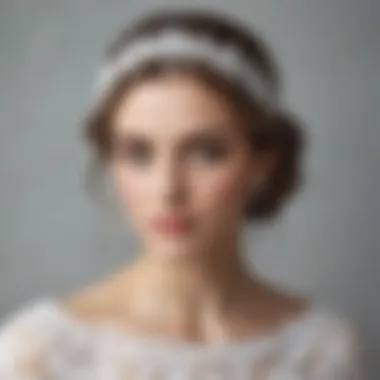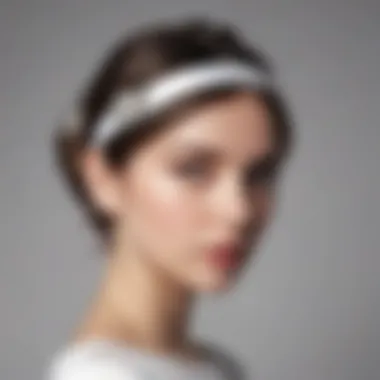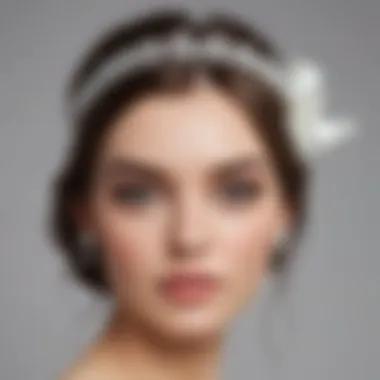The Allure of White Bridal Headbands in Modern Fashion


Intro
In the realm of bridal fashion, the white bridal headband stands out as a quintessential accessory that beautifully links tradition with personal expression. From vintage lace styles to modern silk options, these headbands have woven their way into the hearts of many brides. Their significance is far more than aesthetic; they signify a joyful transition, a moment that is both personal and communal. By wearing a white headband, a bride often pays homage to the generations before her, while simultaneously making a statement about her unique style.
Brides today are more adventurous, diving into a pool of diverse styles and materials, each choice illuminating character and an intimate story. It is this intricate dance between history and modernity that lends a remarkable allure to the white bridal headband, making it not just an accessory, but a piece of art and a chapter in the bride's narrative.
Fashion Trends and Insights
White bridal headbands have seen a resurgence in popularity, elevating them from mere tradition to hot fashion statement. As more brides look for ways to incorporate modern aesthetics into their weddings, understanding current trends is vital.
Current Trends in Clothing Styles
- Minimalist Designs: Elegant simplicity is ruling the day. Brides are opting for sleek designs, allowing the headband to complement rather than overpower the bridal gown.
- Vintage Influences: Many brides are embracing styles reminiscent of the 1920s and 1970s. Think pearl encrusted bands or bohemian floral arrangements. These nods to the past create a sense of timeless sophistication.
- Textured Materials: From satin to lace, the textures used in headbands are ever-evolving. The inclusion of mixed materials adds depth, turning a pretty accessory into a statement piece.
Influential Fashion Icons and Movements
Several iconic figures have made waves in the bridal wear scene, each influencing the trends we see today:
- Kate Middleton: Her royal wedding ensemble redefined bridal elegance with a simple yet stunning headband, igniting interest across the globe.
- Rihanna: Often pushing fashion boundaries, her adventures in headpieces have inspired modern brides to explore bolder and more expressive designs.
"Fashion is the armor to survive the reality of everyday life." - Bill Cunningham
This sentiment appears to resonate deeply within the bridal community, where headbands play a pivotal role in helping brides feel empowered on their special day.
Sustainable Fashion Practices
As the conversation around sustainability grows louder, many brides are considering eco-friendly options. The use of sustainable practices in bridal fashion is not just a trend; it’s becoming a lifestyle choice for many.
Eco-Friendly Fabrics and Materials
Brides can select from a variety of sustainable materials:
- Organic Cotton: Soft and elegant, organic cotton headbands are a graceful choice, minimizing environmental impact.
- Recycled Fabrics: A mindful alternative for those wishing to showcase creativity while being kind to the Earth.
- Biodegradable Embellishments: Crystal and pearl alternatives made from natural materials offer beautiful options that won't contribute to landfill waste.
Tips for Building a Sustainable Wardrobe
To incorporate sustainability into bridal wear:
- Research Designers: Seek designers who prioritize eco-friendly practices and materials.
- Consider Second-Hand: Vintage shops or online marketplaces can be treasure troves for finding unique or previously loved headbands.
- Invest in Versatility: Choose pieces that can be worn again for other occasions, ensuring you get more than one use out of your beautiful bridal accessory.
Prolusion to White Bridal Headbands
The world of bridal fashion is an intricate tapestry woven from threads of history, symbolism, and personal expression. Among the many adornments that have graced brides over the ages, white bridal headbands stand out as both a practical and an aesthetic choice. Their significance extends far beyond mere decoration; they serve as a statement of style, tradition, and even a touch of whimsy.
Understanding Bridal Headbands
To grasp the allure of white bridal headbands, it’s essential to understand their function. A headband isn't just meant to hold hair in place; it's an accessory that frames a bride's face and enhances her overall look. Distinctive in design, a white bridal headband can transform even the simplest of gowns into something extraordinary. These headpieces may vary widely, from delicate lace bands adorned with pearls to bold metal designs featuring intricate artistic elements. Each style tells a story, reflecting the bride's personality, venue, and theme.
In the realm of bridal fashion, the subtle differences between designs can carry sizable implications. For instance, a minimalist headband might cater to a contemporary aesthetic, while a richly embellished piece could evoke vintage charm. Therefore, understanding what makes a bridal headband tick stands as the cornerstone for both bride and stylist alike.
Cultural Context and Tradition
The significance of white bridal headbands cannot be separated from the cultural narratives and traditions that inform them. Throughout history, headpieces have often been steeped in symbolism and cultural lore. In many cultures, the color white signifies purity, innocence, and new beginnings, further elevating the status of white bridal accessories.
The traditions surrounding weddings have evolved, yet certain elements remain steadfast. For example, in Western traditions, brides wear white as a gesture rooted in the Victorian era, symbolizing virtue and chastity. However, many cultures use other colors and styles, showing how versatile and rich the narrative surrounding bridal headwear truly is.
Notably, bridal headbands can also serve a functional role in certain rites. In some cultures, wearing a headband or crown is akin to donning a mantle of responsibility, recognizing the bride’s new role within the family structure. These layers of significance give an added depth to the choice of a white bridal headband, making it not just an accessory but a beacon of tradition and meaning in a bride's journey.
"In every stitch and embellishment, a headband tells a tale of history, culture, and modern-day flair."
In summary, white bridal headbands are more than mere adornments. They encapsulate a realm where history, personal expression, and cultural significance converge, marking a bride's journey into marital bliss. Understanding this complexity invites stylistic choices that reverberate through both the past and future. As we explore their evolution and contemporary styles, one begins to appreciate how they remain pivotal in today’s weddings.


Historical Perspective
The historical perspective of white bridal headbands is a fascinating lens through which we can appreciate not only the evolution of bridal accessories but also the cultural narratives that have shaped them. Understanding this history allows us to connect with the past while influencing modern interpretations of bridal fashion. Significant moments in history have indelibly impacted trends, materials, and styles. Bridal headbands are more than mere fashion statements; they represent a tapestry of traditions and personal expressions woven together through time.
Evolution of Bridal Accessories
Bridal accessories have transformed drastically over the centuries, mirroring the societal shifts and the personal tastes of those who wear them. The evolution of bridal headbands began simply, with natural elements such as flowers or leaves. This primitive approach gradually progressed into more structured and elaborate designs. In the 19th century, headbands often became adorned with lace or embellished with jewels, reflecting changing tastes and standards in fashion. The materials evolved as well, from the use of natural fibers to more luxurious options like silks, metals, and intricate beading. Each step in this evolution mirrors broader cultural trends, offering a glimpse into the changing values surrounding marriage and femininity.
Significant Eras in Bridal Fashion
Victorian Era
During the Victorian Era, bridal fashion saw the emergence of luxurious and ornate styles. The use of white became symbolic of purity, influencing not just gowns but also bridal headbands. A key characteristic of this period was the incorporation of intricate lace and delicate veiling into headbands, which often reflected the bride's social status. Such adornments were considered not only fashionable but also an essential part of a woman's bridal ensemble. The elegance of Victorian headbands highlighted the bride's femininity and sophistication, making it a popular choice during this time.
One unique feature of Victorian headbands was the use of floral embellishments, often crafted from silk or real flowers. These additions served to enhance the overall romantic aesthetic while remaining symbolic—flowers often represented new beginnings and love. However, the heavier materials could sometimes be uncomfortable and unwieldy, posing a challenge for brides seeking both style and ease on their special day.
Roaring Twenties
In the Roaring Twenties, styles took on a decidedly more audacious flair. This era marked a shift toward a more liberated women’s fashion movement, where bridal attire started to reflect individuality rather than just traditional values. The headbands of this period often sported feathers, beading, and bold geometric designs, showcasing a sense of fun and exuberance. This new approach in bridal adornments allowed brides to channel their personal style, displaying their unique identities.
A beneficial aspect of the Roaring Twenties' designs was their capability to pair with less formal gowns, making them versatile for various types of weddings. However, the dramatic styling could overshadow simplicity for brides who preferred a more classic look, which could stand as a slight disadvantage in terms of universal appeal.
Modern Trends
In today’s fashion landscape, modern trends have birthed a plethora of styles, allowing brides to curate their overall look with precision. Contemporary bridal headbands often use a mix of materials that range from simple satin to intricate metals, exhibiting varied textures and finishes. A hallmark of modern styles is the minimalist approach, with designs that emphasize clean lines and understated elegance. This resonates with today’s brides who seek sophistication without excessive embellishments.
A notable feature of modern headbands is their adaptability, which allows them to blend seamlessly with diverse wedding themes—from bohemian to classic dignity. One downside, however, is that with such a vast array of options, some brides might feel overwhelmed by choices. The challenge lies in finding a piece that resonates emotionally and fits within the overall wedding aesthetic.
Each era has left its mark on bridal fashion, showcasing the fluidity of style and preferences through time. Exploring these periods offers brides insights not only into their own choices but also into the rich traditions that have paved the way for contemporary designs.
Contemporary Styles of White Bridal Headbands
Contemporary styles of white bridal headbands represent a crucial aspect of modern bridal fashion. With the rise of individualism and a shift towards personal expression in weddings, these headbands have evolved beyond mere accessories. Now, they cater to a variety of tastes and preferences, offering something unique for every bride.
Selectin the right headband can elevate a bridal look from simple to stunning, making it essential for brides and their stylists to consider the various options available. In this section, we will delve into the materials and design variations that define contemporary styles, exploring how each contributes to the elegance of bridal ensembles.
Materials and Textures
The material of a bridal headband speaks volumes about its style and impact. Choices range from soft lace to sleek metal and intricate beading, each offering distinct aesthetics and feelings.
Lace
Lace headbands add a touch of timeless elegance. Known for their delicate patterns and ethereal charm, they bring a soft, romantic feel to any bridal outfit. Lace has a rich history in bridal attire, often associated with classic bridal looks. One key characteristic is its versatility; lace can be paired with various hairstyles, from soft curls to sleek updos.
While lace is often favored for its beauty, it does come with some disadvantages. For example, lace can be delicate and may require careful handling during wear, especially in outdoor settings where it may snag.
Metal
Metal headbands offer a striking contrast to softer materials, embodying a more modern, chic vibe. Made from materials like gold, silver, or brass, these headbands add shine and sophistication to any bridal look. Their key feature is durability—metal headbands are typically robust and can withstand the rigors of a busy wedding day.
Unfortunately, metal can also be less comfortable for some brides, especially if the band is too tight or the edges are sharp. It's crucial for brides to ensure a proper fit to enjoy this elegant style fully.
Beading
Beading offers another layer of glamour. Headbands adorned with beads can catch the light beautifully, adding sparkle and dimension to a bride's overall look. Beaded designs often feature intricate patterns, showcasing craftsmanship that can elevate the entire outfit.
The unique feature of beaded headbands lies in their ability to transform even the simplest dresses into fashion statements. However, they can be heavier than other options, possibly causing discomfort during long ceremonies or receptions. Finding the right balance between style and comfort is crucial for brides considering this option.
Design Variations
The design of a headband can change its overall effect on a bridal ensemble immensely. The current trends focus on diverse designs, from floral embellishments to minimalist aesthetics, ensuring that every bride can find her unique style.
Floral Accents
Floral accents on headbands bring an organic and romantic element, ideal for brides who want to channel a bohemian vibe. These designs often feature fabric flowers, or even real blooms, adding a personal touch to the bridal appearance. The enchanting quality of floral headbands makes them a popular choice for outdoor weddings and garden ceremonies.
However, while they are undeniably beautiful, floral headbands may not suit all wedding themes or personal styles, and they require careful maintenance to look their best, especially if using real flowers.
Minimalist Designs


On the flip side, minimalist designs are favored for their simplicity and elegance. These headbands often consist of smooth, unadorned materials that embody modern sophistication. Their understated look works well for brides looking for a refined yet stylish option.
One advantage of minimalist designs is their ability to complement various bridal gowns without overwhelming the overall look. However, some brides may find them too plain, depending on personal taste and the desired wedding theme.
Statement Headbands
For the bold bride, statement headbands provide an opportunity to stand out. Often featuring elaborate designs, such as oversized bows or intricate patterns, these headbands serve as the focal point of the bridal look. They are a way for brides to express their personality and creativity while making a strong fashion statement.
Yet, with great boldness comes great responsibility; statement headbands require careful coordination with the dress and overall bridal look to avoid clashing. Finding the right balance is essential for achieving that stunning effect.
Ultimately, the choice of headband can define a bride's overall look and influence the ambiance of the wedding.
The contemporary styles of white bridal headbands not only mirror trends but also cater to a broad spectrum of tastes, ensuring that every bride can find a piece that speaks to her individuality.
Choosing the Right Headband
Selecting the right bridal headband is akin to finding the perfect puzzle piece that completes a masterpiece. It serves not only as an accessory but also as a statement of individuality in what is often considered a pivotal moment in life. The significance of this choice goes beyond personal style; it encapsulates the bride's vision, enhances the wedding theme, and can profoundly impact her overall look on that special day.
A well-chosen headband can beautifully frame the face, complement the bridal gown, and signify an understanding of timeless fashion principles. It's essential to consider several factors when making this decision, particularly one's face shape and how the headband aligns with the overarching wedding aesthetic.
Considerations for Face Shape
Round Faces
For brides with round faces, the key characteristic is the soft contour and fullness of cheeks. This face shape benefits from headbands that provide angularity. A well-crafted piece with sharp designs and linear elements can create the illusion of length and structure. Think of a sleek, satin band or a metallic option that draws the eye upward, highlighting features rather than softness. Round-faced brides often find that this style accentuates their bone structure while allowing their natural beauty to shine through.
Advantages: A headband that adds length can be flattering, and many designs suit floral or elaborate themes, enhancing the overall bridal look.
Square Faces
Square faces, defined by a strong jawline and forehead, offer an engaging challenge when it comes to headband selection. Here, the aim should be to soften the angularity of the features. Headbands with rounded edges, like those adorned with delicate flowers or flowing ribbons, work exceptionally well. A slightly embellished piece can soften sharp outlines and add an air of romanticism that balances the definition of a square face.
Advantages: Using floral or textured headbands can introduce a sense of lightness, leaving a lasting impression that blends rather than conflicts with the bride's natural features.
Oval Faces
The oval face shape is often considered the most versatile, with balanced proportions that lend themselves well to various styles. For oval-faced brides, the world is practically their oyster—almost any headband can work! A thin, minimalist band or an opulent, beaded option can each find a rightful place. The unique feature of the oval shape is its adaptability; brides can play with various widths and embellishments, creating a diverse range of looks.
Advantages: The flexibility in choices allows brides to express their personality freely, be it through intricate designs or simple elegance that complements the gown beautifully.
Aligning with the Wedding Theme
When coordinating a headband with the wedding theme, the dialogue goes deeper than aesthetics. It's about creating a cohesive narrative that reflects not only the couple's love story but also the atmosphere they wish to cultivate on their special day.
For instance, a rustic outdoor wedding may benefit from a floral-accented headband made of natural materials, while a glamorous venue calls for a sparkling, jeweled piece that catches the light. The headband must resonate with the overall colors and styles of the wedding, becoming a unifying element in the bridal ensemble.
In summary, finding the ideal bridal headband is not merely a matter of matching colors or materials. It's a process of ensuring that each choice, especially concerning face shape and wedding theme, harmonizes to create an unforgettable look that speaks volumes about the bride’s personal journey.
Styling Tips
When it comes to bridal fashion, the right styling can be the cornerstone of a flawless look. Styling tips serve more than just an aesthetic purpose; they help integrate the bridal headband into the overall ensemble, ensuring that it resonates with the bride's personal style. Selecting the right headband and knowing how to style it effectively can vastly elevate the bridal outfit, allowing the headband to shine without overshadowing other elements.
Integrating with Hair Styles
Updos
Updos are a classic choice for brides wanting a sophisticated and polished look. This hairstyle allows the bridal headband to truly stand out, as it frames the face beautifully. A key characteristic of updos is their versatility—whether it's a sleek bun or a textured chignon, there’s an option for every bride. Furthermore, they create an elegant backdrop, letting the headband showcase its intricate details. The advantages of choosing an updo include the enhanced visibility of the headband, making it a focal point of the bridal look. However, one must consider personal comfort as tightly pulled styles can sometimes lead to discomfort throughout the day.
Loose Waves
On the other hand, loose waves offer a relaxed and enchanting vibe, perfect for a bohemian or beach-themed wedding. This style embodies elegance while maintaining an effortless feel. One of the major benefits of loose waves is that they can seamlessly incorporate a headband, whether it’s placed on top of the waves or nestled comfortably within them. This approach allows the headband to add a touch of whimsy without competing with the softness of the waves. Yet, brides should note that loose waves may require additional styling products to hold their shape.
Braids
Braids have an inherent charm that can blend traditional and modern styles. They come in various forms—fishtail, Dutch, or even waterfall braids—and can accentuate the white bridal headband in imaginative ways. The textural dimension of braids allows them to complement most headband designs, drawing attention to intricate embellishments. Notably, braids are highly adaptable; they can be arranged to fit both elaborate and minimalist aesthetics. One notable advantage of braiding hair is its ability to hold up under various conditions, ensuring the headband stays securely in place. However, stylists should be careful, as excessive tightness can lead to a look that feels more restrictive than celebratory.


Complementing Bridal Attire
The relationship between the bridal headband and the overall attire is paramount. It’s vital for a bride to consider how the headband meshes with elements like the gown's neckline or fabric type. For instance, a delicate lace headband might harmonize beautifully with a dress that features similar lace detailing. Attention to these details ensures coherence throughout the look and helps create a striking visual balance that celebrates the day’s special essence.
"The right headband doesn’t just complete the look; it tells a story."
The Symbolism of White in Bridal Wear
The color white holds profound significance in bridal attire, particularly in the context of headbands. For centuries, the color has been associated with purity, innocence, and new beginnings. This symbolism varies across different cultures but resonates universally as a depiction of the bride's new journey into matrimony. Choosing a white bridal headband can amplify this message, serving not just as an accessory but as an emblem of the bride's personal story and heritage.
Cultural Significance of White
White has been a traditional choice for brides since Queen Victoria wore a white gown at her wedding to Prince Albert in 1840. This marked a shift from the common practice of wearing elaborate colors which was often based on practicality rather than symbolism. Today, the color white is synonymous with bridal fashion in many Western cultures, but its significance stretches far beyond, resonating with various customs.
In many societies, white represents a clean slate. In Eastern cultures, it can sometimes embody mourning, highlighting the stark contrast in how colors carry differing meanings. Nevertheless, when it comes to bridal wear, white is generally embraced for its ability to symbolize hope and new beginnings. As brides don headbands that echo this color, they echo their commitment and aspirations for the future.
"The white bridal headband is not just a piece of jewelry; it is a reflection of heritage, dignity, and the promise of tomorrow."
Moreover, the resurgence of diverse wedding cultures has also seen brides opting for mixed colors but still incorporating white elements as a nod to tradition. Thus, as bridal designers and retailers brainstorm their collections, understanding this cultural nuance can be critical in catering to the wants and needs of modern brides.
Psychology of Color
Diving into the psychological aspects, the color white evokes feelings of calmness and tranquility. Studies in color theory suggest that white is associated with clarity and simplicity—characteristics that many brides seek on their wedding day amidst the chaos of planning. The act of wearing white can invoke a sense of peace or emotional stability, allowing the bride to feel more centered during such a monumental occasion.
Furthermore, the allure of white headbands lies in their ability to enhance the overall look without overshadowing other elements of the wedding ensemble. They provide a striking contrast to richly decorated gowns, serving as subtle tools to maintain focus on the bride herself. When brides choose white bridal headbands, they not only embrace tradition but consciously leverage the positive psychological effects the color imparts—creating an atmosphere of joy, excitement, and anticipation.
Care and Maintenance of Headbands
Taking care of white bridal headbands may not be the most glamorous aspect of wedding prep, but it’s essential for ensuring these delicate pieces retain their beauty. After all, most brides want their headband to look pristine on the big day and possibly beyond. Proper care and maintenance not only helps in preserving the aesthetics but also extends the lifespan of these accessories.
The significance of care lies in the materials used in white bridal headbands. From intricate lace to glimmering beads, different materials have their own requirements. Understanding how to clean and store these headbands can make all the difference. It’s more than just aesthetics; dirty or poorly maintained headbands can attract unwanted attention and detract from the bridal look.
Cleaning Techniques
Cleaning a bridal headband requires a gentle touch, especially if it’s made from delicate materials. Here are a few techniques to keep things fresh:
- Handwashing: For lace or fabric headbands, a simple hand wash with mild detergent in lukewarm water is ideal. Avoid soaking them for too long to maintain their shape.
- Spot Cleaning: For minor stains, use a soft cloth with a mixture of water and a tiny bit of white vinegar. Gently dab the affected area to lift the stain without damaging the fabric.
- Avoid Harsh Chemicals: Stay away from bleach or aggressive cleaning agents. They can ruin the color and integrity of the materials used, leading to irreversible damage.
- Drying: After washing, lay the headband flat on a clean towel. Avoid wringing it out, as this might distort its shape. Allow it to air dry completely, away from direct sunlight.
Taking these steps will maintain the pristine look of the headband while also ensuring it’s ready for the spotlight.
Storage Recommendations
Once you’ve cleaned your bridal headband, proper storage comes next. Here’s how to do it right:
- Use a Soft Pouch: Store the headband in a silk or soft fabric pouch to protect it from dust and potential scratches.
- Keep it Flat: Avoid bending or folding the headband. Instead, lay it flat in a drawer or on a shelf. For stiffer designs, like metal headbands, consider using a jewelry box that’s cushioned to prevent crushing.
- Avoid Humidity: Store in a cool, dry place. Humidity can cause materials like lace or fabric to mold, ruining the accessory altogether.
- Organize with Care: If you own multiple headbands, label them or keep them in separate containers to prevent mix-ups or accidental damage.
Proper care and storage can elevate a headband from ordinary to exceptional, making sure it captures every lovely moment of the day.
By paying attention to these aspects, brides can ensure that their white bridal headband remains as stunning on the day of their wedding as it was the moment they first laid eyes upon it. Taking the time to clean and store it right reflects the overall preparation and thoughtfulness that goes into the bridal attire. This commitment not only highlights the headband’s allure but also showcases the bride’s attention to detail and personal style.
Through these meticulous practices, the headband will continue to hold its charm, possibly becoming a cherished heirloom for generations to come.
End
Bridal fashion is not just about fabric and color; it's about artistry, personal identity, and cultural heritage. The white bridal headband encapsulates this essence beautifully. It draws ties to historical and contemporary trends, while allowing each bride to express her uniqueness through subtle adornment.
The lasting impact of the white bridal headband lies in its ability to transcend mere decoration. It is a symbol— a reflection of dreams, love, and commitment. When selecting a headband, it's crucial to consider not only the practical aspects, like style and fit, but also the emotional significance it may hold.
The Lasting Impact of the White Bridal Headband
The white bridal headband carries various meanings across different cultures. For some, it embodies purity and elegance, while for others, it may signify a rite of passage. The materials used—be it delicate lace or shimmering metal—can evoke different emotions. Each choice, each detail, can echo the bride’s journey leading up to the big day.
"A bridal headband can transform a look instantly; it’s like putting on a crown, no matter how simple it is."
Indeed, the impact of these headbands goes beyond fashion; they often serve as cherished heirlooms that families pass down from one generation to the next. Brides can feel an inexplicable connection to their own heritage when donning a piece that has meaning beyond the aesthetic.
In this realm of bridal adornment, the headband becomes an extension of one's personality. Designers and stylists are encouraged to explore creative pathways to incorporate headbands into their collections, emphasizing their versatility and charm. The current market is ripe with opportunity for innovative designs that resonate with a modern audience while respecting traditional values.



